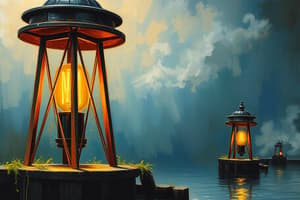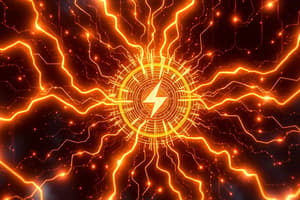Podcast
Questions and Answers
What does the symbol for a variable resistor include?
What does the symbol for a variable resistor include?
- An arrow through it (correct)
- A straight line
- Two circles
- No special markings
In a parallel circuit, the potential difference is different for each component.
In a parallel circuit, the potential difference is different for each component.
False (B)
What is the equation for current?
What is the equation for current?
Q = It
A thermister's resistance increases with ______.
A thermister's resistance increases with ______.
What is the purpose of step-up transformers in the National Grid?
What is the purpose of step-up transformers in the National Grid?
Match the types of wires used in homes to their functions:
Match the types of wires used in homes to their functions:
Total resistance in a series circuit is the sum of the individual resistances.
Total resistance in a series circuit is the sum of the individual resistances.
What average voltage is electricity delivered to homes?
What average voltage is electricity delivered to homes?
Flashcards
What is current?
What is current?
Current is the flow of electric charge. It's measured in Amps (A).
What is voltage?
What is voltage?
The potential difference (voltage) drives electrons through a circuit. It's measured in Volts (V).
What is resistance?
What is resistance?
Resistance opposes the flow of current. It's measured in Ohms (Ω).
Series circuits: total potential difference
Series circuits: total potential difference
Signup and view all the flashcards
Series circuits: total resistance
Series circuits: total resistance
Signup and view all the flashcards
Series circuits: current
Series circuits: current
Signup and view all the flashcards
Parallel circuits: potential difference
Parallel circuits: potential difference
Signup and view all the flashcards
Parallel circuits: total current
Parallel circuits: total current
Signup and view all the flashcards
Study Notes
Circuit Symbols
- There are 12 circuit symbols to learn
- The variable resistor has an arrow through it
- The thermister does not have an arrow
- The fuse has a straight line through it
- Arrows within circuit symbols represent light
Current
- Current is defined as the flow of electric charge
- The equation for current is Q=It where:
- Q = Charge (Coulombs)
- I = Current (Amps)
- t = Time (Seconds)
- Current flows through wires via electrons
- Imagine wires as roads, electrons as cars, and charge as passengers
Potential Difference/Voltage
- Voltage drives electrons through a circuit
- Imagine voltage as the engine of a car
Resistance
- The equation for resistance is V=IR where:
- V = Potential Difference (Volts)
- I = Current (Amps)
- R = Resistance (Ohms)
- Resistance can be affected by:
- Strength of components (like resistors)
- Filament lamps
- Length and diameter of wires
- Imagine resistance as traffic on a road
Light Dependent Resistor (LDR)
- An LDR's resistance is dependent on light intensity
- Higher light intensity = lower resistance
- Remember the graph of the relationship between light intensity and resistance to remember this rule
Thermister
- A thermister's resistance is dependent on temperature
- Higher temperature = lower resistance
- Remember the graph of the relationship between temperature and resistance to remember this rule
Series Circuits
- Components are connected in a single loop
- Total potential difference is the sum of all PDs in the circuit
- Current is the same everywhere in the circuit
- Total resistance is the sum of all resistances in the circuit
Parallel Circuits
- Components are connected in branches
- Potential difference is the same everywhere in the circuit
- Total current is the sum of all currents in the circuit
- Current splits at junctions
- In two resistors wired in parallel, total resistance is lower than the smallest resistor
Electricity in the Home
- Red Wire (Live): Carries the current
- Green and Yellow Wire (Earth): Grounds the electricity for safety
- Blue Wire (Neutral): Completes the circuit
- Power equation: P=IV where:
- P = Power (Watts)
- I = Current (Amps)
- V = Potential Difference (Volts)
The National Grid
- Power stations produce electricity
- The National Grid aims to deliver this electricity to homes
- Step-up transformers increase voltage in wires to reduce current:
- This reduces resistance
- Prevents overheating
- Reduces energy loss through thermal energy
- Step-down transformers reduce voltage to a safer level
- Electricity is delivered to homes at 230 volts on average.
Studying That Suits You
Use AI to generate personalized quizzes and flashcards to suit your learning preferences.




